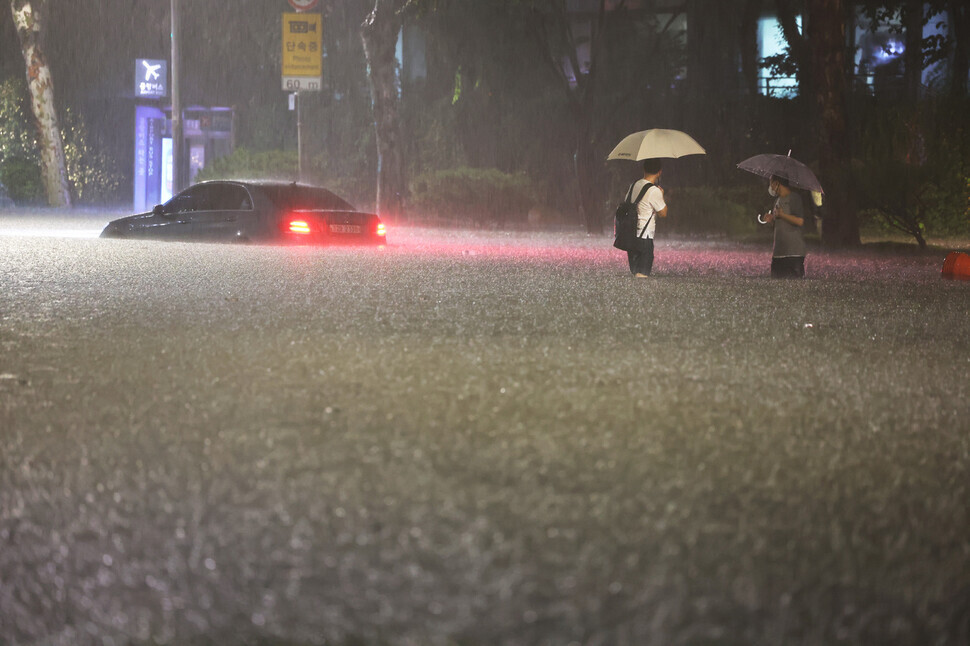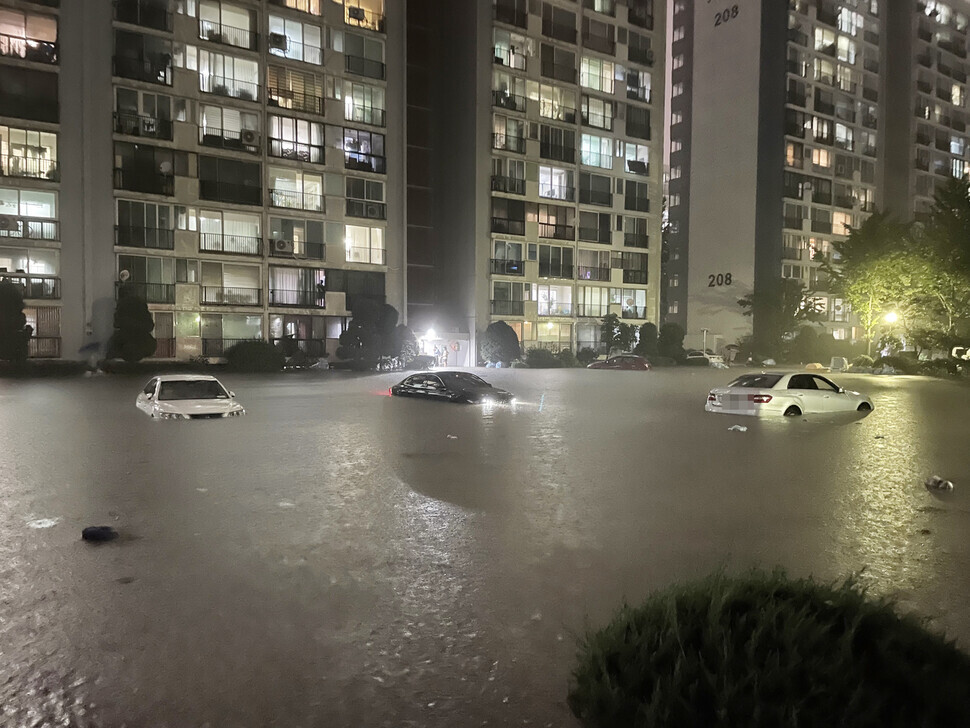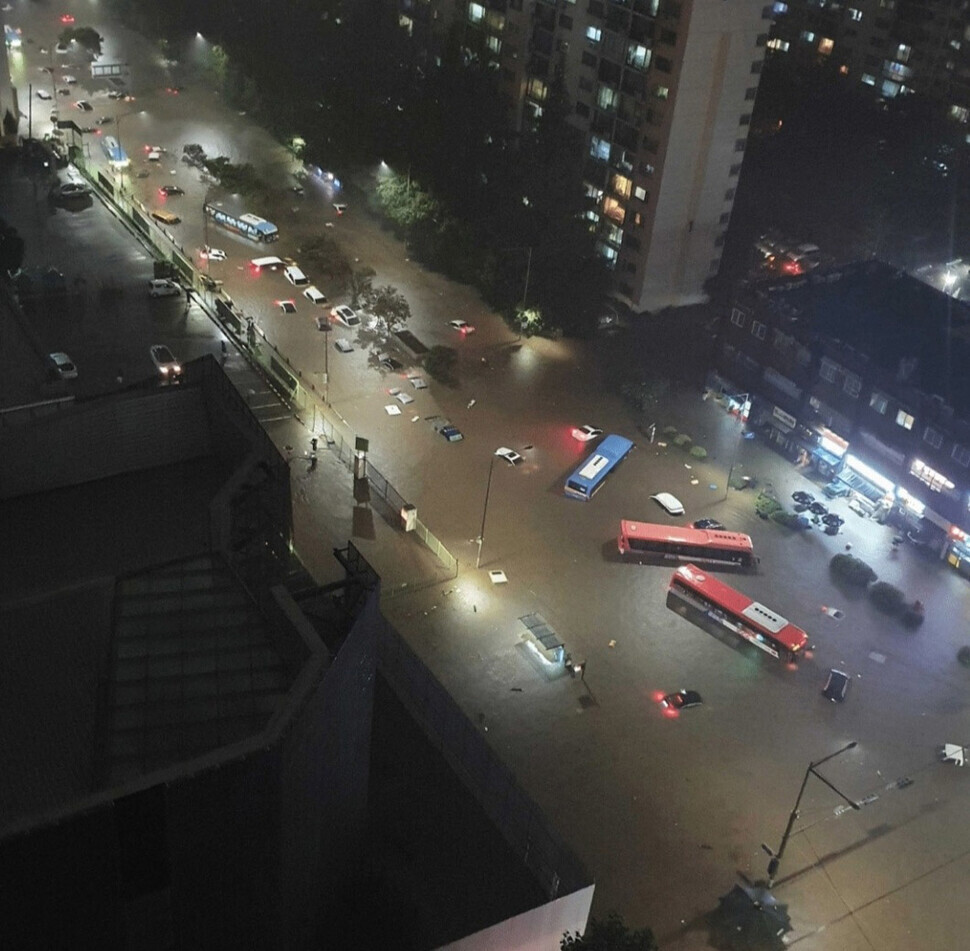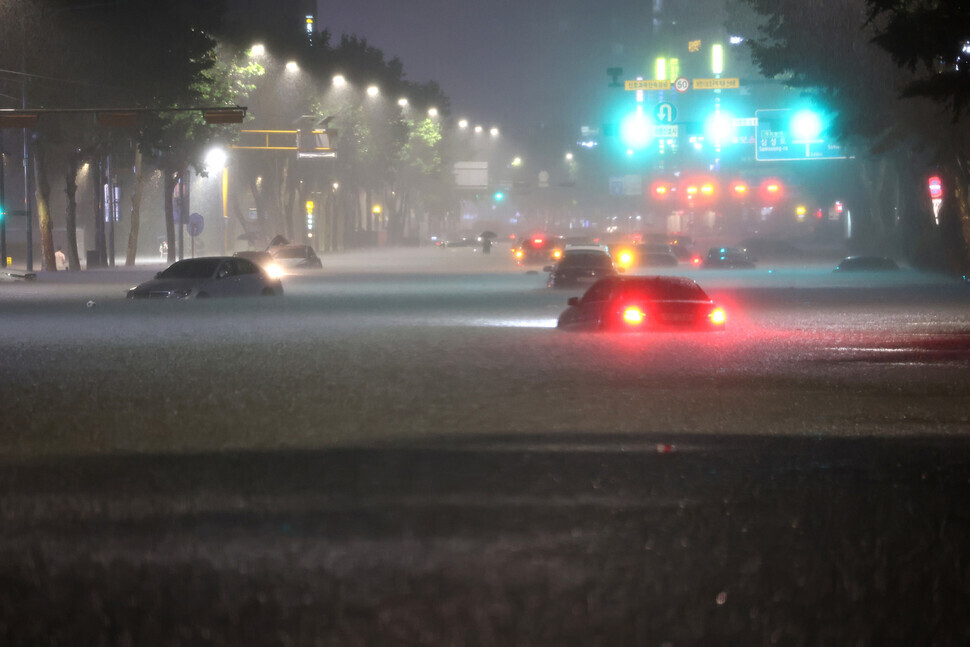hankyoreh
Links to other country sites 다른 나라 사이트 링크
Greater Seoul area battered by heaviest rainfall in 102 years

Narrow rain clouds cutting across southern Incheon, southern Seoul, Gyeonggi Province, and Gangwon Province caused record downpours that started around 8 pm Monday, resulting in flooding, power outages, and leakages across South Korea. Roads and subway stations on low-lying land south of the Han River in Seoul flooded, the water level reaching up to waist-high and catching commuters headed home from work off guard.
Landslide warnings were raised in as many as 11 of the 25 autonomous districts in Seoul, the acute weather situation continuing well into the early morning hours.
According to the Korea Meteorological Administration (KMA), 119 millimeters (4.68 inches) of rain fell in Seoul alone as of 11 pm Monday. A whopping 380 millimeters (14.9 inches) of rain poured down on Dongjak District, where the KMA is located. This broke the record for heaviest rainfall in Seoul, set on Aug. 2, 1920, when 354.7 millimeters inundated the capital city.
The amount of rainfall in Dongjak District between 8 pm and 9 pm alone came out to 136.5 millimeters. Daily precipitation hit 316.5 millimeters in Gwangmyeong, Gyeonggi Province, 242.5 millimeters in Incheon’s Bupyeong District, 242 millimeters in Bucheon, Gyeonggi Province, and 158 millimeters in Cheorwon, Gangwon Province.
The KMA explained, “A stationary front moved south and north from around the central region, and strong rains of 50 to 80 millimeters per hour accompanied by lightning and thunder raged in regions where rain clouds with a narrow north-south width stretching from east to west flowed in.”
The situation was especially dire in southern Seoul and the Gangnam area. The Seoul city government restricted vehicles and pedestrians from passing through Jamsu Bridge from 10 pm to midnight. This was because the Han River’s water level had reached 6.2 meters, necessitating traffic control, due to the increased outflow of water from the upper Paldang Dam.

The traffic information division of the Seoul city government also announced around 9:29 pm that four lanes of Teheran Street from Samseong Station to the Posco intersection were flooded, for which reason traffic was completely shut down in both directions.
Around 8 pm, roads near Gangnam station in Seoul flooded due to sewer overflow. Three to four lanes of the section from Seocho to Banpo on the Gyeongbu Expressway towards Seoul went underwater around 9 pm, with traffic allowed to pass only on one lane.
Starting at 6:30 pm, traffic was restricted on all sections of the Dongbu Expressway from Surak Underpass to Seongsu JC. This was because torrential rain in Seoul and northern Gyeonggi Province caused Jungrang Stream’s water level to rise.
Additionally, traffic was shut down on some sections of the Nambu Beltway, and major thoroughfares through Yangjae and Yeouido. Around 9 pm, stores within Gangnam Express Bus Terminal had flooded, and water leaked into the COEX building in the Samseong neighborhood. The power abruptly went out in the Gangnam and Seocho areas as well.
Subways halted operations across Seoul. Yeongdeungpo Station on Line 1 flooded, causing southern-bound trains to stop operation. Signal failures and delays occurred at Oryu-dong Station on the Gyeongin Line and Geumcheon District Office Station on Line 1. Wastewater leaked into Isu Station on Line 7, prompting trains to pass through the station without stopping. Panels making up platform ceilings buckled under the rainwater’s weight. Dongjak Station on Line 9 was closed as well.

People took to social media, posting videos and photos alerting others of the flooding situation on roads, inner roads, and subway stations in Samseong, Seocho, Sadang, and Isu late into the night with the hashtag “#SubwayFlooding.”
Jeong Seong-ho, 45, who works in the Seocho neighborhood of Seoul, got trapped in his office at around 10 pm due to shin-high floodwater. Jeong shared pictures and videos of the flooding situation with his friends. “It felt like a disaster movie,” he said.
Kim, 55, who lives in Seongbuk District, got stuck outside when roads near the Express Bus Terminal Station unexpectedly flooded. “I have to go to work tomorrow, but I can’t even go home,” he said.
Some people ended up having to look for lodging, as they couldn’t figure out a way home.
“I wasn’t able to go anywhere from near Gangnam Station,” said a 34-year-old surnamed Lee, “so I ended up booking accommodation nearby with an app.”
Some commuters got trapped in their cars. A twenty-something who was driving home from Dongjak to Sadang had to stop his car on the road as the water level rose. They said, “In the opposite direction, a vehicle someone had left there was floating on the water.”

Some residents were evacuated due to stream flooding and landslide alerts. The Gwanak District Office in Seoul issued an evacuation order, stating that Dorim Stream was flooding due to heavy rainfall that continued into the night. The Gwanak District’s emergency management agency alerts residents residing in flood-prone areas to “quickly evacuate to safety” around 9:26 pm.
The Gwanak District Office also ordered residents in some areas to evacuate around 11 pm citing risk of landslides. When torrential rain continued in the Seoul area, causing considerable damage, Seoul Mayor Oh Se-hoon returned to his office at Seoul City Hall around 9:55 pm to keep an eye on the emergency.
Lives were lost as well. The Central Disaster and Safety Countermeasure Headquarters announced that an individual who was clearing up fallen trees in Dongjak District died, presumably from electrocution.
A Chinese electrician in their 50s who was performing electricity work outside a construction site in the Sincheon neighborhood of Siheung, Gyeonggi Province, also died from an electric shock around noon.
Around 5:56 pm, an iron panel at a construction site near Yaksu Station in the Jung District of Seoul fell over, injuring a pedestrian.
By Jang Na-rye, staff reporter; Lee Keun-young, senior staff writer; Kim Seon-sik, staff reporter
Please direct questions or comments to [english@hani.co.kr]

Editorial・opinion
![[Column] Has Korea, too, crossed the Rubicon on China? [Column] Has Korea, too, crossed the Rubicon on China?](https://flexible.img.hani.co.kr/flexible/normal/500/300/imgdb/original/2024/0419/9317135153409185.jpg) [Column] Has Korea, too, crossed the Rubicon on China?
[Column] Has Korea, too, crossed the Rubicon on China?![[Correspondent’s column] In Japan’s alliance with US, echoes of its past alliances with UK [Correspondent’s column] In Japan’s alliance with US, echoes of its past alliances with UK](https://flexible.img.hani.co.kr/flexible/normal/500/300/imgdb/original/2024/0419/2317135166563519.jpg) [Correspondent’s column] In Japan’s alliance with US, echoes of its past alliances with UK
[Correspondent’s column] In Japan’s alliance with US, echoes of its past alliances with UK- [Editorial] Does Yoon think the Korean public is wrong?
- [Editorial] As it bolsters its alliance with US, Japan must be accountable for past
- [Guest essay] Amending the Constitution is Yoon’s key to leaving office in public’s good graces
- [Editorial] 10 years on, lessons of Sewol tragedy must never be forgotten
- [Column] A death blow to Korea’s prosecutor politics
- [Correspondent’s column] The US and the end of Japanese pacifism
- [Guest essay] How Korea turned its trainee doctors into monsters
- [Guest essay] As someone who helped forge Seoul-Moscow ties, their status today troubles me
Most viewed articles
- 1[Column] The clock is ticking for Korea’s first lady
- 2After 2 months of delayed, denied medical care, Koreans worry worst may be yet to come
- 3[Column] Has Korea, too, crossed the Rubicon on China?
- 4US overtakes China as Korea’s top export market, prompting trade sanction jitters
- 5[Editorial] When the choice is kids or career, Korea will never overcome birth rate woes
- 6[Correspondent’s column] In Japan’s alliance with US, echoes of its past alliances with UK
- 7[Photo] Smile ambassador, you’re on camera
- 8Hong Se-hwa, voice for tolerance whose memoir of exile touched a chord, dies at 76
- 9Nearly 1 in 5 N. Korean defectors say they regret coming to S. Korea
- 10Strong dollar isn’t all that’s pushing won exchange rate into to 1,400 range